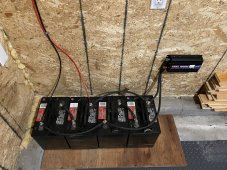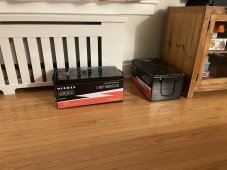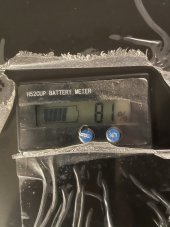I purchased calb 302ah cells from docan power (no affiliation) and a JBD BMS for a 24v battery build. Cost $1150. I am upgrading to a Samlex Evo 4248 and 8 more cells for our fifth wheel (50 amp). Eventually I will have two batteries and a roof full of solar so I won't have to plug in If I don't want to. It's a lot of work but knowing we have power if we can't find a spot in a campground (it happened) is a relief.
You are using an out of date browser. It may not display this or other websites correctly.
You should upgrade or use an alternative browser.
You should upgrade or use an alternative browser.
Inverter/Charger for use with horrible park power? RV to run soley off Solar/Batteries.
- Thread starter ryankenn
- Start date
Vigo
Solar Addict
I just fed some PSUs 80v and they put out about 30% of their max capacity. FYI!
I may try putting it through one of my ‘travel converter’ autotransformers, boosting it up to 160v, and seeing whether it works better with the input switch on 110 or 220v.. ?
I may try putting it through one of my ‘travel converter’ autotransformers, boosting it up to 160v, and seeing whether it works better with the input switch on 110 or 220v.. ?
Last edited:
My small test system to run a 300W baseboard heater using the panels I got for the camper, my old 6V golf cart batteries and some Ali Express breakers, inverter and charge controller. Hopefully I don't burn it down. Do you normally also put a disconnect between the inverter and batteries? I have a 25A from the panels, and a 50A between the 60A charge controller and batteries right now.






I have also been watching this guy on YT, and these cells he now has a 48V pcb to turn 2 of the 24V into a 48V/50ah for $450 including the board. Just need a BMS.

 jag35.com
jag35.com

SLM24 LiFePO4 24v 50A 8s Battery | Jehu Garcia JAG35.com DIY Powerwall Batteries EV eBikes eScooters eBoards
PLEASE READ THE DESCRIPTION CAREFULLY. Shipping to Lower 48 USA states only via Fedex Ground Shipping. No international shipping, including Hawaii, Guam, Puerto Rico. Non-USA customers click here. 24v LFP energy storage capable of 50A continuous discharge in 8s configuration. Safer, better...
 jag35.com
jag35.com
My small test system to run a 300W baseboard heater using the panels I got for the camper, my old 6V golf cart batteries and some Ali Express breakers, inverter and charge controller. Hopefully I don't burn it down. Do you normally also put a disconnect between the inverter and batteries? I have a 25A from the panels, and a 50A between the 60A charge controller and batteries right now.
View attachment 121718View attachment 121719View attachment 121720
300 watts isn’t much heat. Probably the best bang for the buck for a camper is an 24volt RV diesel heater. You probably have enough battery power to run that. Do your research to find the quietest one. On low they just sip ounces of fuel per hour and make tons of heat. They are nice because there’s no propane stink inside and don’t deplet oxygen. All the combustion products are outside.
Last edited:
This is a heater for my attached garage at home, I am just testing the setup as I have never done solar before so I figured a small setup will let me iron out the kinks. I immediatly discovered the PwrMR 60A, even though it has a rated OC Voltage for 160V for the panels, that it is for 48V. At 12V I can only have 80V so I had to disconnect one panel. Oddly, its overcast today and when I put the panels on the voltage jumps around quite a bit. Started at 72V and worked its way jumping around and settled at about 24V then was pulling a measily 8W I ran out of sun but tomorrow they should be in full sun so I can test more.300 watts isn’t much heat. Probably the best bang for the buck for a camper is an 24volt RV diesel heater. You probably have enough battery power to run that. Do your research to find the quietest one. On low they just sip ounces of fuel per hour and make tons of heat. They are nice because there’s no propane stink inside and don’t deplet oxygen. All the combustion products are outside.
Vigo
Solar Addict
The jumping around is primarily the charge controller seeking the ‘maximum power point’. It’s normal.
Voltage also varies widely with panel ‘illumination’ but its pretty intuitive because if youre next to a window you can correlate it with the shade from passing clouds without any mental contortions.
Voltage also varies widely with panel ‘illumination’ but its pretty intuitive because if youre next to a window you can correlate it with the shade from passing clouds without any mental contortions.
I also discovered the solar disconnects I bought are polarized, they have a positive and negative side, and I had the panels reversed. So when the sun comes out tomorrow hopefully I will be charging!
How long does the controller normally seek before settling in?
How long does the controller normally seek before settling in?
Vigo
Solar Addict
I have only watched a handful of mppts working (5?) but i would say less than 30 seconds. The voltage will still fluctuate once it is ‘in the ballpark’ of mppt, just by less and more slowly.
Well my first big step was taken, I ordered some batteries from AliExpress to use at the trailer. The company is a "no name" Wulills, but they have good reviews, the few negatives seemed to all have been resolved with refunds. The seller was responsive and the size I ended up with ships from within Canada, so not only do I get them faster but without duty which is a big savings. I ordered (2) 12V 280ah which I will use as 24V at the park, but can use here as 12v in the offseason. They have a 150A BMS so I can run the trailer without issue.
We will see when they arrive, but on Black Friday they were $1756CAD total to my door.
We will see when they arrive, but on Black Friday they were $1756CAD total to my door.
Usually it’s a better idea for lithium, if you need 24 volts, get a 24 battery. Two Lifepo4’s in series can have one run ahead of the other during charge. If one goes to far ahead the bms could disconnect the charge and the net result is less overall capacity. Series is done all the time but you just need to keep an eye on it. When you first get them, charge them in parallel to whatever they say is the maximum battery voltage(14.6?). When you have them in series, periodically check at full charge to see if they are running up together. If you have the ability to adjust your maximum charge voltage, set it at 28 volts, there’s really no capacity gained by going higher and it gives you wiggle room for imbalance before a bms shuts down. If you see one battery start to run at full charge you can put a load across that one battery to pull it back down or put it back in parallel to balance the batteries. Hopefully the batteries are built similar and probably are when purchased at the same time. Always give them the same treatment, don’t use one battery alone for 12 volts, put them in parallel for that. They need the same work history. When in parallel, make sure that no battery has a shorter cable path. Congratulations on getting new power!Well my first big step was taken, I ordered some batteries from AliExpress to use at the trailer. The company is a "no name" Wulills, but they have good reviews, the few negatives seemed to all have been resolved with refunds. The seller was responsive and the size I ended up with ships from within Canada, so not only do I get them faster but without duty which is a big savings. I ordered (2) 12V 280ah which I will use as 24V at the park, but can use here as 12v in the offseason. They have a 150A BMS so I can run the trailer without issue.
We will see when they arrive, but on Black Friday they were $1756CAD total to my door.
They actually make those but they were originally made for lead acid. Some repackage them and say good for “lithium”. Stay away from from them.I will keep an eye on it. Too bad you can't get a 2S BMS as I could just treat each battery as a cell in a larger pack. Is there anyone that makes something to keep batteries in balance in this type of config?
Vigo
Solar Addict
All you need is a small 12-to-15v step up converter and 2 small relays to ‘swap’ the hots between batteries on some kind of repeating schedule, and as long as the converter massively outflows your accumulation of ‘imbalance’ it should correct all the issues.. right? I mean, its GOT to be that simple right? ?
Vigo
Solar Addict
Cool! Im assuming that built in meter can be set to show voltage as well? The same thing is sold as a stand alone component which autodetects nominal voltage (12/24/48) and then ballparks SOC purely from voltage in a fixed (probably lead-acid based, therefore very wrong) way. Id be surprised if that screen were actually driven by the bms and reported ‘accurate’ SOC. But if so, cool!
So anyway, what’s the voltage because if it’s like 12.4-12.5v that’s a lead acid based % number, which while oversimplistic on lead is totally wrong for lithium, therefore you would know to ignore that % function for the rest of eternity. If the voltage is like 13.2-13.2 id be curious enough about how it worked to look into it further, and maybe end up actually giving it some slight weight if for example it was actually driven by the BMS.
So anyway, what’s the voltage because if it’s like 12.4-12.5v that’s a lead acid based % number, which while oversimplistic on lead is totally wrong for lithium, therefore you would know to ignore that % function for the rest of eternity. If the voltage is like 13.2-13.2 id be curious enough about how it worked to look into it further, and maybe end up actually giving it some slight weight if for example it was actually driven by the BMS.
What could go wrong? ?All you need is a small 12-to-15v step up converter and 2 small relays to ‘swap’ the hots between batteries on some kind of repeating schedule, and as long as the converter massively outflows your accumulation of ‘imbalance’ it should correct all the issues.. right? I mean, its GOT to be that simple right? ?
One battery is at 12.4V and says 81%, the other is 13.1V and says 89%Cool! Im assuming that built in meter can be set to show voltage as well? The same thing is sold as a stand alone component which autodetects nominal voltage (12/24/48) and then ballparks SOC purely from voltage in a fixed (probably lead-acid based, therefore very wrong) way. Id be surprised if that screen were actually driven by the bms and reported ‘accurate’ SOC. But if so, cool!
So anyway, what’s the voltage because if it’s like 12.4-12.5v that’s a lead acid based % number, which while oversimplistic on lead is totally wrong for lithium, therefore you would know to ignore that % function for the rest of eternity. If the voltage is like 13.2-13.2 id be curious enough about how it worked to look into it further, and maybe end up actually giving it some slight weight if for example it was actually driven by the BMS.
That is to say you can scroll the display through to Volts. I have to sit down and see what else you get.
Last edited:
Vigo
Solar Addict
Ok. 12.4v does not correlate to 81% capacity on a "12v" lifepo4, so that screen is doing what i said and applying an oversimplistic rule, incorrectly to boot, to an lifepo4 battery and giving you a totally inaccurate % number. I just wanted to make you aware of that possibility so you know to ignore the % readout in the future. 12.4 is more like ~10% on a lifepo4, but voltage is not a great way to assess SOC on lifepo4 because over most of the SOC range the voltage barely changes at all.
Last edited:
Similar threads
- Replies
- 0
- Views
- 331
- Replies
- 16
- Views
- 409
- Replies
- 18
- Views
- 1K
- Replies
- 30
- Views
- 2K
- Replies
- 17
- Views
- 611





